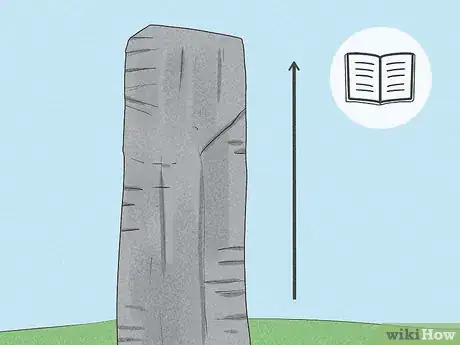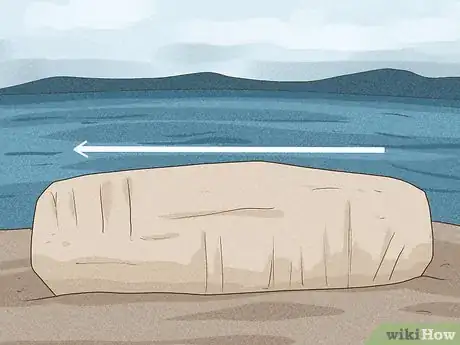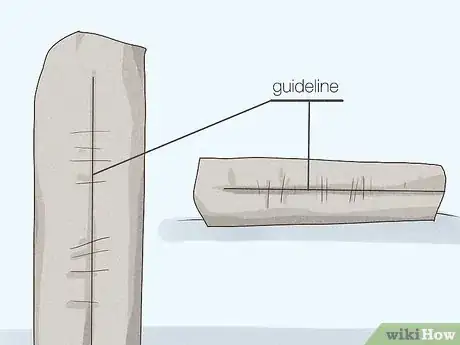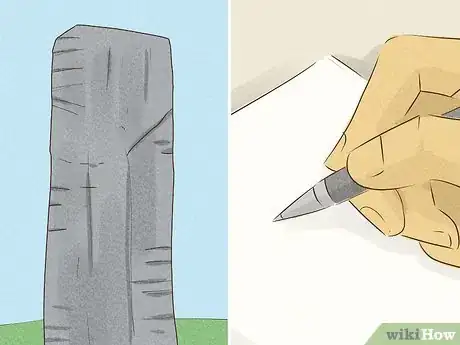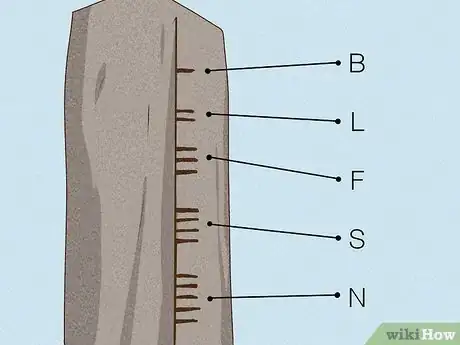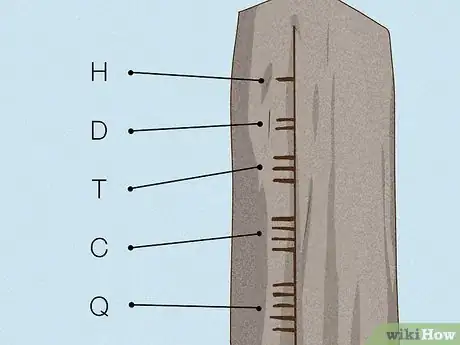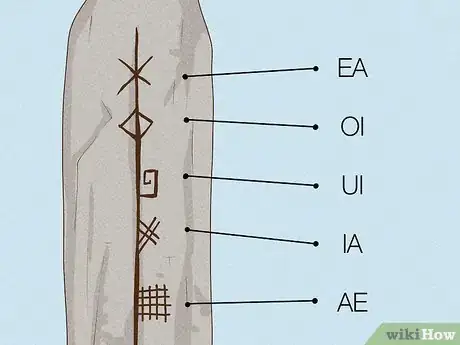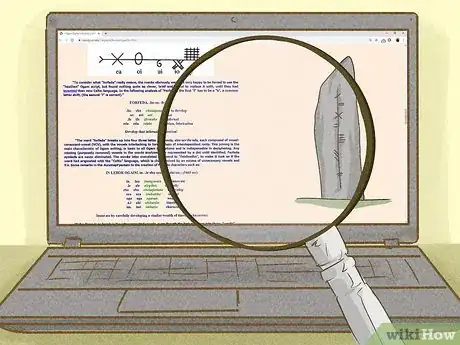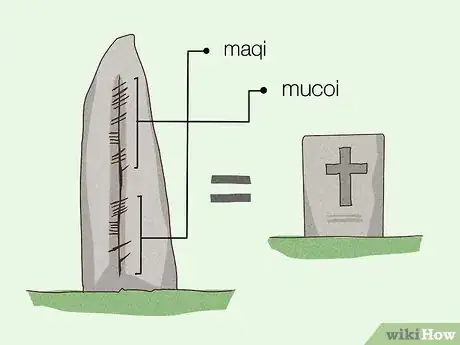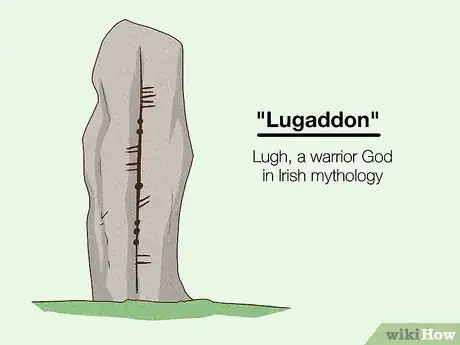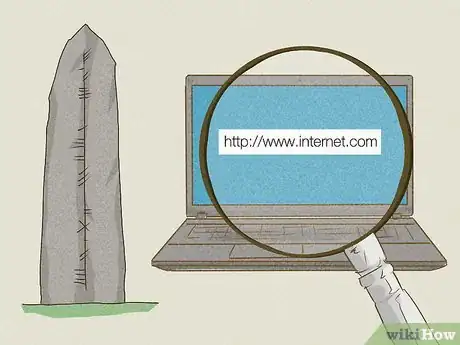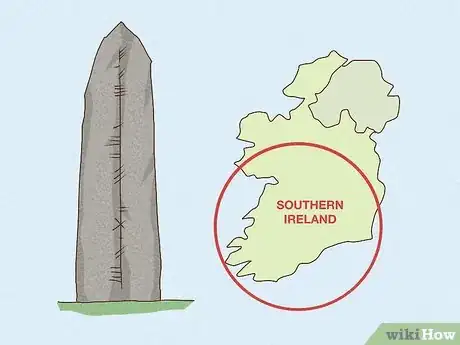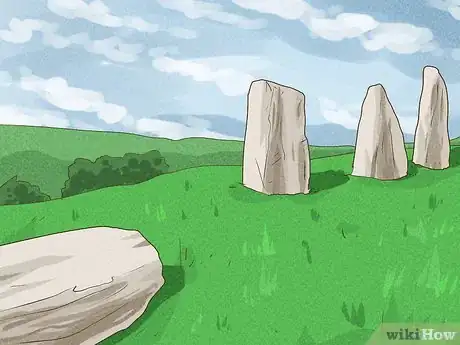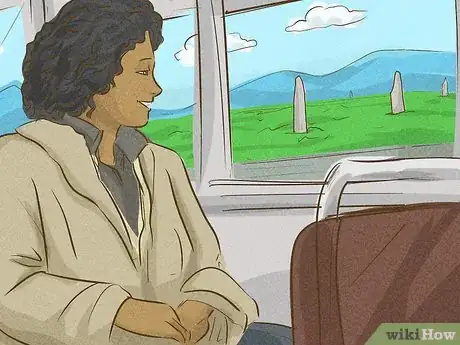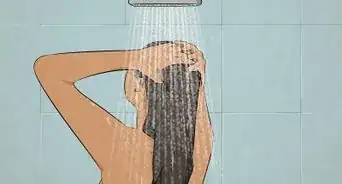This article was co-authored by wikiHow staff writer, Eric McClure. Eric McClure is an editing fellow at wikiHow where he has been editing, researching, and creating content since 2019. A former educator and poet, his work has appeared in Carcinogenic Poetry, Shot Glass Journal, Prairie Margins, and The Rusty Nail. His digital chapbook, The Internet, was also published in TL;DR Magazine. He was the winner of the Paul Carroll award for outstanding achievement in creative writing in 2014, and he was a featured reader at the Poetry Foundation’s Open Door Reading Series in 2015. Eric holds a BA in English from the University of Illinois at Chicago, and an MEd in secondary education from DePaul University.
There are 14 references cited in this article, which can be found at the bottom of the page.
This article has been viewed 16,030 times.
Learn more...
The Ogham stones refer to stone monuments inscribed with messages from ancient Celtic tribes. The messages are all in Ogham, which is the earliest form of Irish language. These 400 stones are sprinkled around the coasts of the Irish Sea in Ireland, Wales, England, and the Isle of Man. Unless you’re fluent in ancient forms of Gaelic, reading the stones will prove fairly difficult. However, if you’re patient and have a keen eye, you can translate each stone to a legible form of Primitive Irish and translate that into your language.
Steps
Facing the Stone and Orienting Yourself
-
1Read the stone from the bottom to the top if it’s vertical. If the Ogham stone sits vertically in the ground, start on the bottom and work your way to the top. Look for the lowest mark available and work your way up. Any gaps in the markings indicate the separation of a word, although you may need to separate them yourself after you translate it if the marks are close together.[1]
- Many of these stones are weathered away from centuries of erosion. You may only be able to figure out what some of the message means.
-
2Go from the right to the left if the stone is horizontal. Horizontal stones tend to be much harder to read. For one, they tend to be more worn down than the vertical stones. In addition, it’s hard to figure out which side is the right and which side is the left since you can stand on either side. If you’re near water, assume that you face the water to read the stone.[2]
- If the stone is embedded next to a hill or large rock, assume you read the stone by facing the geological feature it’s next to.
- If you translate a horizontal stone and the message simply doesn’t make sense, you may have stood on the wrong side of the stone. Unfortunately, there’s no way around this.
Tip: Often, there is a V-shaped etching at the beginning of the line to indicate the beginning of the sentence. Keep in mind this isn’t universal, though.
Advertisement -
3Find the guideline by looking for the longest line in the middle of the hash marks. Every Ogham inscription is placed along a single line that guides the sentence. Look for a long, thin line carved into the stone. On a vertical stone, this line starts on the ground and goes up. On a horizontal stone, it will run the length of the stone.[3]
- This line is sort of like the line on a piece of notebook paper that guides a sentence.
- Many of the Ogham stones use a corner as the vertical line that guides the inscription. If the marks are on a sharp edge of the stone, treat the entire corner as the line you need.
- Letters in Ogham are determined based on their relationship to this line. For example, a single mark going to the left of the line is the letter H, while a single line going right of the line is a B. A single line that goes both right and left of the line is actually an A.
-
4Write the letters down as you read the stone. To translate the stone yourself, grab a notebook and a pencil. It is much easier to write the letters down as you work and separate them later for translation. If you’re in a time crunch, you can draw the entire carving and translate the drawing later.[4]
- If you’re on vacation with your family, they probably aren’t going to be happy about you sitting in front of a stone for 20 minutes to translate a 1500-year-old burial stone. These readings can take some time.
- You can always take a photo if you’re really in a rush.
Deciphering the Letters
-
1Treat changes in the pattern as new letters and spaces as new words. Some of the stones have gaps between each set of markings. Treat these gaps as new words. You can find where a new letter starts by looking for a change in the pattern. Every letter in Ogham is a series of repetitive marks (or a single mark), so if the pattern changes, it’s a new letter.[5]
- If there are no spaces, you’ll need to do some guessing when it comes to separating the letters out into individual words.
Tip: Each of the translated marks correspond to a Romanized version of the Ogham alphabet, meaning the sounds have been converted to Latin. You’ll still need to translate from Primitive Irish to your language, but this basically the only way to go about this.
-
2Look for horizontal hash marks that stick out right for N, S, F, L, and B. If you see any sets of straight horizontal marks sticking out of the right of the central guideline carved in the stone, count how many hash marks appear next to one another to determine the letter. Keep in mind, the hash marks must form a 90-degree angle (or close to it) off of the main line on the stone.[6]
- One mark – B
- Two marks – L
- Three marks – F
- Four marks – S
- Five marks – N
-
3Use horizontal marks that go left to note Q, C, T, D, and H. You will also note several horizontal marks that stick out to the left of the main line. Again, these marks must form 90-degree angles to the central line guiding the message.[7]
- One mark – H
- Two marks – D
- Three marks – T
- Four marks – C
- Five marks – Q
-
4Note lines that run at an angle to find R, Z, NG, G, and M. Some of the hash marks are not perfectly perpendicular to the central line. These marks rest at an angle on the central line, although they’ll always run in the same direction parallel to one another. These slanted marks always extend all the way through the center line.[8]
- One mark (at an angle) – M
- Two marks (at an angle) – G
- Three marks (at an angle) – NG
- Four marks (at an angle) – ST (or Z)[9]
- Five marks (at an angle) – R
-
5Spot I, E, U, O, and A by looking for horizontal marks that bisect the guideline. If a horizontal line runs all the way through the center line (i.e. to the right and left), it is a vowel. Luckily, the Romanized vowels of Primitive Irish are identical to English which makes translating a little easier. Keep in mind, these lines must sit at a 90-degree angle on both sides of the center line.[10]
- One mark – A
- Two marks – O
- Three marks – U
- Four marks – E
- Five marks – I
-
6Treat dots that appear on the guideline as alternative ways to write vowels. On many of the Ogham stones, the original author used dots instead of lines to indicate vowels. If you see some round notches etched into the center line, treat these dots like vowels. On a handful of stones, the dots appear next to the center line.[11]
- One dot – A
- Two dots – O
- Three dots – U
- Four dots – E
- Five dots – I
-
7Interpret the runic symbols as vowel groupings and use both letters. Ogham only uses lines and dots to produce letters, but many of the older Ogham stones contain symbols that do not conform to the alphabet. These symbols relate to pronunciations or vowel groups, and they are often used as shorthand for names. Include both vowels in your translation.[12]
- An X carved over the center line – EA
- A square bisected on opposite corners by the center line – OI
- A sequence of 90-degree angles forming a curl – UI
- Two sets of parallel lines sticking out of the center line and crossing – IA
- A checkerboard pattern – AE
Translating the Ogham
-
1Search each individual word online to decode what it means. Once you’ve converted the entire sentence into Primitive Irish, look each word up in a search engine to find what it means in your language. Unfortunately, there are no reliable Primitive Irish translation tools online, so you’ll have to look each word up individually.[13]
- There is a formula you can use to convert the letters to Basque (a language in Europe) and look the definitions up in a complete dictionary, but this is kind of complicated. It’s much easier to search the word on its own.[14]
- Some words are unknown and have not been completely translated.
-
2Look for words “maqi” or “mucoi” to note memorials to the dead. Most of the Ogham stones are memorials to the dead. The Celtic people that used Ogham are thought to have erected these stones for funerary purposes. You’ll often find “maqi,” which means “son of” or “mucoi,” which roughly means “of the tribe.” If you spot either of these words, you’re looking at a burial stone![15]
- You may also stumble on “maqiritte,” which is a combination of “son” and “stone.” It roughly translates to “the stone of…”
- Some of the stones have odd inscriptions or phrases. One stone reads, “To compare with the name of the horse.”[16]
-
3Treat every word with no translation as a name. If you cannot find the meaning of a word you translated, the odds are extremely high that it is someone’s name. It may also be the name of Celtic family or tribe if it appears after the word “mucoi.” Assume these unfamiliar words are names.[17]
- Often, the names are Gods. The word “lugaddon” appears often on the stones. This is a reference to Lugh, a warrior God in Irish mythology.
Did You Know?: Some of the stones are just a list of names. Some historians suggest that some of the stones may represent contracts or agreements between tribal leaders. Legend has it that two parties would make a deal, touch a hole in the stone, and swear on their ancestors that they’d keep their word. Then, a scribe would document the agreement by carving their names in the stone.[18]
-
4See if the stone you found has a full translation online to check your work. Many of the stones have been fully translated, and you can find the full text in your language in a reference work online. Search online for the stone that you found by typing in the location followed by the phrase “Ogham stone.” If any scholars have translated it, you’ll be able to check your work and see how close you got![19]
- Some of the stones have not been translated. They’re either too worn down, or the original author wasn’t very careful with their carving.
Finding Ogham Stones
-
1Look for the stones in southern Ireland if you’re seeking them out. The largest concentration of Ogham stones is in southern Ireland. Roughly 360 of the stones are found in Ireland, while the other 40 or so are spread across the coasts of England, Wales, and the Isle of Man. If you really want to see the stones, Ireland is hands down your best bet.[20]
- The stones outside of Ireland are mostly older and were mainly carved between 800-1100 CE.
Did You Know?: Most of the stones were made between 400-700 CE. The vast majority of them are monuments to the dead, although none of the stones are found at gravesites. Interestingly enough, the Ogham language is the earliest form of writing in Ireland![21]
-
2Visit Stone Corridor in Cork for the largest museum collection. The biggest catalogued collection of stones is at the University College of Cork, in the city of Cork. The school maintains a collection of 20 stones, which can be found in a hallway on the western side of the campus. Stop by the university to take a look.[22]
- You can also call the university to see if they offer guided tours.
-
3Go to the Dingle Peninsula in Kerry to find the stones yourself. The single largest collection of unexcavated stones is found in Corca Dhuibhne, also known as the Dingle Peninsula, which is in County Kerry. Roughly 60 stones are found here, but there are hundreds of other megaliths and ancient monuments as well. If you’re going relic seeking on your own, this is hands down the best place to find some ancient artifacts![23]
- If you’re staying in Ireland specifically to go look at artifacts in the Dingle Peninsula, the port town of Dingle is a great place to stay. If larger cities are more your vibe, stay in Tralee, which is a popular tourist spot just outside of the peninsula.
-
4Keep an eye out for tall stones with horizontal hash marks on them. In your travels, look for large stone tablets embedded in the ground. The Ogham stones are all different, but most of them are 8–14 feet (2.4–4.3 m) tall. If you spot a stone sticking out of the ground, look to see if it has horizontal lines carved all over it. If it does, you just found an Ogham stone![24]
- Some of the stones sit horizontally on the ground, but the vast majority of them are planted vertically.
- A handful of the stones have signs or placards next to them, so keep an eye out for modern signs set up near large stones as you’re traveling around. However, many of the stones are just sitting out in nature.[25]
- Unfortunately, it can be hard to find maps of where the stones are located. You can search online to see if there are any stones in the county or area where you’re staying, though!
Things You’ll Need
- Pencil
- Paper
References
- ↑ http://ogham.lyberty.com/oghamintro.html
- ↑ https://faculty.ucr.edu/~legneref/bronze/ogamScri.htm
- ↑ https://www.bbc.co.uk/northernireland/saintpatrick/common/pdf/activity_sheet6_en.pdf
- ↑ https://www.bbc.co.uk/northernireland/saintpatrick/common/pdf/activity_sheet6_en.pdf
- ↑ http://ogham.lyberty.com/oghamintro.html
- ↑ https://www.bbc.co.uk/northernireland/saintpatrick/common/pdf/activity_sheet6_en.pdf
- ↑ https://www.bbc.co.uk/northernireland/saintpatrick/common/pdf/activity_sheet6_en.pdf
- ↑ https://www.bbc.co.uk/northernireland/saintpatrick/common/pdf/activity_sheet6_en.pdf
- ↑ https://www.dochara.com/places-to-visit/megalithic-sites/ogham/
- ↑ https://www.bbc.co.uk/northernireland/saintpatrick/common/pdf/activity_sheet6_en.pdf
- ↑ http://ogham.lyberty.com/oghamintro.html
- ↑ https://www.dochara.com/places-to-visit/megalithic-sites/ogham/
- ↑ https://faculty.ucr.edu/~legneref/bronze/ogamScri.htm
- ↑ https://faculty.ucr.edu/~legneref/bronze/vcvdict.htm
- ↑ http://titus.uni-frankfurt.de/didact/idg/kelt/ogamabb.htm
- ↑ https://everything.explained.today/Ogham_inscription/
- ↑ http://titus.uni-frankfurt.de/didact/idg/kelt/ogamabb.htm
- ↑ http://www.ancientpages.com/2019/06/17/ogham-unique-enigmatic-irish-writing-and-signaling-tool-preserved-in-stone-inscriptions-and-manuscripts/
- ↑ https://faculty.ucr.edu/~legneref/bronze/ogamScri.htm
- ↑ https://dingle-peninsula.ie/8-explore-the-dingle-peninsula/history-and-archaeology/219-ogham-stones.html
- ↑ https://www.historytoday.com/story-ogham
- ↑ https://www.ucc.ie/en/discover/visit/centre/stone-corridor/
- ↑ http://www.irishmegaliths.org.uk/kerry.htm
- ↑ http://www.megalithicireland.com/Ogham%20Stones%20Page%201.htm
- ↑ https://www.dochara.com/places-to-visit/megalithic-sites/ogham/
- ↑ https://www.historytoday.com/story-ogham
- ↑ https://www.historytoday.com/story-ogham
- ↑ https://ogham.co/primitive-irish-language/book_of_ballymote/
